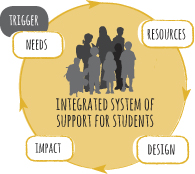Design elements
Target for support (strengths and needs)
Resource Teachers of Literacy (RTLit) provide specialised literacy assistance to learners in years 1 to 8 who are experiencing difficulties with literacy learning.
RTLit provide English reading literacy, written literacy, and oral language support to teachers of identified students or the targeted students.
Expected outcomes
Accelerated progress for identified learners through:
- advice and support for classroom teachers (indirect support)
- intensive specialised teaching to individual and/or small groups (direct support).
What data is used to support access decision?
Literacy information for each student – this includes overall teacher judgments, norm referenced assessment scores, running records, student examples of reading/comprehension tasks, and description of other supplementary support, for example, Reading Recovery.
Delivery design (who, how long, interactions)
Schools trigger an application process by contacting their cluster’s management committee. RTLit and management committees should take note of the following priorities for RTLit instruction:
- Students “referred” from Reading Recovery
- Students that have the highest literacy needs on the waiting list
Students referred to the RTLit service should be those with the highest literacy needs in the school. However, selection for instruction by RTLit should prioritise those with the highest literacy needs in the cluster.
On average, directly supported students received 37 half-hour units of support over 16 weeks, and indirectly supported students received 14 half-hour units over 15 weeks.
There are two types of instruction:
- Direct – where the RTLit provides to individual and/or small groups of students.
- Indirect – where the RTLit supports the teacher to deliver appropriately designed learning opportunities within the classroom. The teacher, RTLit (and students) work together.
How will the support contribute to classroom practice (tier 1) and school capability?
The major focus of RTLit work will be in the area of indirect instruction, which provides support to the classroom teacher to deliver appropriately designed learning opportunities within the classroom.
Fidelity elements (small groups, one on one, timing)
Both direct and indirect instruction should be used flexibly and deliberately, based on professional judgment and careful analysis of the student’s strengths and needs. Both approaches are recorded in units or part-units of time.
Indirect instruction:
- The teacher, RTLit (and students) work together. Where a group of students have similar learning needs, they can be grouped for instruction.
Direct instruction is used less frequently. It is useful for diagnostic purposes where the RTLit wishes to gain greater insight into the teaching and/or learning. 1:1 short intensive teaching with a student may be required to break a pattern of the student’s ineffective learning behaviour. This teaching may or may not occur within a classroom but should be balanced carefully with the need to enable the student’s learning to take place within the normal classroom setting as soon as possible.
How is support monitored and measured in terms of outcomes?
RTLit are required to monitor and report on student progress to the teacher, the school, the cluster, and the Ministry of Education.
Definitions of status of ‘discharged’ students:
Successfully discontinued – when the RTLit judges a student as working at or close to the expected National Standard and able to fully benefit from effective classroom teaching.
Referred on – when the RTLit and management committee have made a decision that the student is not making sufficient progress to be successfully discontinued within an appropriate time, and the student needs further intensive support from other services.
Withdrawn – when the student is no longer able to receive RTLit instruction (but is not successfully discontinued or referred on), which could be for a variety of reasons. For example, the student has left the area.
Rolled over – when instruction for the student is to be rolled over into the next year, but data is taken at the end of the year and reported as part of the annual reporting cycle.
What needs to be sustained?
Throughout a student’s programme, the RTLit and class teacher carefully monitor the student’s progress and liaise frequently. Working together will mean the teachers will be best placed to make decisions about what appears to be effective teaching for the student.
Regular monitoring and reporting will also ensure that the classroom teacher and the school will be well informed about the student’s progress, and decisions to discontinue or refer a student will be deliberate, planned, and well communicated throughout the student’s time on the RTLit roll. Schools monitor and support the progress of students in classroom programmes post-intervention.
The RTLit can support the school with regards to the relationship with parents, family and whānau, and encourage meaningful learning-focused engagement.
Roles and responsibilities for the support
What are the conditions for successful delivery?
Provider
Cluster Management Committee responsibility is for:
- employment of RTLit
- overseeing the allocation/priority of students and schools to RTLits
- ensuring data is collated to describe successfully discontinued, referred on, withdrawn, rolled over.
RTLit:
- provides supports to cluster of schools, responsible for acceleration of individual students on their roll, and responsible for teacher/leader learning around needs identification and improved responses to students
- sends achievement data to teacher and school leader and collated data to Cluster Management Committee and annually to MoE.
School
In order for an RTLit to be most effective it is paramount that the student’s RTLit and classroom teachers liaise and communicate regularly.
The school must have effective systems in place to closely monitor the progress of students who successfully complete RTLit for a period of three years, intervening immediately when progress is not as expected.
The school also needs systems for identifying and providing support for the students who were not successful.
System/MoE
- System provides overview/funding
- Annual data management/analysis of impact
- Review/evaluation of services
Return to top

